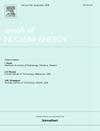液态金属冷却反应堆电站停电瞬态建模的半分析方法
IF 2.3
3区 工程技术
Q1 NUCLEAR SCIENCE & TECHNOLOGY
引用次数: 0
摘要
开发了一种模拟液态金属反应堆电站停电性能的半解析方法,允许识别决定瞬态峰值温度的关键因素,从而设计相关的被动安全系统。结果表明,通过适当的冷却剂通道、一次系统和船舶空气冷却回路的尺寸,可以保证燃料包壳在这一瞬态过程中的完整性。这些尺寸是使用代数方程和最小/最大允许雷诺数的假设值,燃料包壳管几何形状和散热器高度的无因次参数,保护容器高度,标称核心功率,容器空气冷却系统中的允许温度梯度和空气冷却系统烟囱高度确定的。该模型表明,所需的冷却剂体积是堆芯功率快速增长的函数,而钠冷却反应堆的冷却剂体积需要比铅冷却反应堆大40%。本文章由计算机程序翻译,如有差异,请以英文原文为准。
A semi-analytical method for modelling station blackout transients in liquid metal-cooled reactors
A semi-analytical method for modelling station blackout performance in liquid metal reactors is developed, permitting to identify key factors determining peak temperatures during the transient, and hence to design associated passive safety systems. It is shown that integrity of the fuel cladding during this transient can be ensured by adequate dimensioning of coolant channels, the primary system and the vessel air cooling circuit. These dimensions are determined using algebraic equations and postulated values for a minimum/maximum permissible Reynolds number, dimensionless parameters for the fuel cladding tube geometry and heat sink elevation, a guard vessel height, the nominal core power, permitted temperature gradients in the vessel air cooling system and the air cooling system chimney height. The model suggests that the required coolant volume is a rapidly growing function of core power, and that this volume needs to be 40% larger in a sodium-cooled reactor than in a lead-cooled reactor.
求助全文
通过发布文献求助,成功后即可免费获取论文全文。
去求助
来源期刊

Annals of Nuclear Energy
工程技术-核科学技术
CiteScore
4.30
自引率
21.10%
发文量
632
审稿时长
7.3 months
期刊介绍:
Annals of Nuclear Energy provides an international medium for the communication of original research, ideas and developments in all areas of the field of nuclear energy science and technology. Its scope embraces nuclear fuel reserves, fuel cycles and cost, materials, processing, system and component technology (fission only), design and optimization, direct conversion of nuclear energy sources, environmental control, reactor physics, heat transfer and fluid dynamics, structural analysis, fuel management, future developments, nuclear fuel and safety, nuclear aerosol, neutron physics, computer technology (both software and hardware), risk assessment, radioactive waste disposal and reactor thermal hydraulics. Papers submitted to Annals need to demonstrate a clear link to nuclear power generation/nuclear engineering. Papers which deal with pure nuclear physics, pure health physics, imaging, or attenuation and shielding properties of concretes and various geological materials are not within the scope of the journal. Also, papers that deal with policy or economics are not within the scope of the journal.
 求助内容:
求助内容: 应助结果提醒方式:
应助结果提醒方式:


